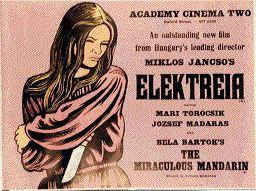
IN ASSOCIATION WITH NATIONAL FILM ARCHIVE OF INDIA, PUNE,
ELEKTREIA
Hungary/1974/Col/75 min
DATE OF SCREENING : 29 JULY 2007 9.30 AM
VENUE : SAVITHA THEATRE, ERNAKULAM
Director : Miklos Jancso
Screenplay : Laszlo Gyurko and Gyula Hernadi
Cinematography : Janos Kende
Music : Tamas Cseh
Lyrics : Geza Beremenyi and Gyula Hernadi
Choreography : Karoly Szigeti
Cast : Mari Torocsik (Electreia), Jozsef Madaras (Aegisthos), Gyorgy
Cserhalmi (Orestis), Maria Bajcsay and Lajos Balazsovits (The
Courtiers), Gabi Jobba (Chrisothemis)
Fifteen years after the murder of her father, King Agamemnon, Elektra still cherishes the belief that her exiled brother Orestes will return to assassinate the murderer, the tyrant Aegisthus. On the anniversary of Agamemnon’s death, Aegisthus orders his oppressed people to celebrate and announces Orestes’s death; but the body he displays is not Orestes'. Then a messenger arrives with news of Orestes’ actual death; Aegisthus exalts, and Elektra bitterly strikes down the messenger. But the latter rises from the dead, revealed as Orestes himself. The people rebel and turn on Aegisthus, making him their plaything. Orestes kills the tyrant’s two chief courtiers, and then Aegisthus himself. He and Elektra recognise that their role is to die and to be continually reborn like the phoenix, which they identify with the red firebird of revolution.
In this film, which was the Hungarian entry at Cannes, 1975, Jancso has produced a Summing Up, a comprehensive synthesis of the particular genre he has created: an extraordinarily suggestive blend of ballet, the musical and the “happenings” that expresses his attitudes towards socio-philosophical problems.
Most movies are composed of many small snippets of film which are spliced together, connected by "wipes," and "dissolves" and any number of other clever techniques which move the eye (and the story) from one piece of film to the next without being too obtrusive. Renowned Hungarian director Miklos Jancso has instead shot this film recounting the classical story of Electra's revenge in about nine “long takes." This is a technical feat of some magnitude; it is all the more remarkable because he makes it seem perfectly natural to the story, which is told in an allegorical and highly symbolic fashion, mixing primitive Greek settings with modern ones. In it, the woman Electra seeks vengeance for the murder of her father. Due to the highly abstract form of storytelling used, this film might best be appreciated by those who have studied or have knowledge of the original Greek myth on which it is based.
Miklós Jancsó
A key figure in the development of the new Hungarian cinema, filmmaker Miklós Jancsó earned international recognition for his films 'Szegénylegények,' (The Round-Up, 1965), 'Csillagosok Katonák,' (The Red and the White, 1967), and 'Csend és Kiáltás,' (Silence and Cry, 1968).
These films best reflect Jancsó's tendency toward abstraction and contain a distinctive combination of revolutionary viewpoints and highly structured, formal cinematic style. Imagery is more important than dialogue, which is used sparingly to encourage audiences to contemplate Jancsó's underlying messages. The director tends to place actors in geometric patterns that mirror the landscapes around them.
Born in Vac, Hungary, Jancsó studied ethnography and art history while earning his law degree in 1944. He spent several years in Transylvania doing ethnographic research before enrolling in Budapest's Academy of Dramatic and Film Art, where he graduated in 1950.
Jancsó began filming numerous newsreels and documentary shorts until 1958, when he made his feature debut with 'A Harangok Rómába Mentek,' (The Bells Have Gone to Rome, 1958). The film is one of the few in Jancsó's repertoire that does not reflect his signature style. In 1963, he earned international acclaim for his medical drama, 'Oldás és kötés,' (Cantata, 1963).
Many of Jancsó's films examine the terrible aftermath of war. Although his first films offered sympathetic explorations of the human characters, his later works became increasingly concerned with the use of imagery for its own sake. Jancsó's landmark films of the '60s won many international awards and special recognition at the Cannes Film Festival. In 1972, he again earned international acclaim and the Best Director Award at Cannes for Red Psalm.
'Elektreia,' (Szerelmem, Elektra, 1974) consists of just 12 shots in a film lasting 70 minutes. Five years later, Jancsó won a lifetime achievement award from the prestigious French film festival. He continued to make films throughout the rest of the century, earning particular acclaim for a number of increasingly enigmatic works, including 'Szeressuk Egymast Gyrekek...A Nagy Agyhalal,' (Let's Love One Another...The Great Brain Death, 1996) and 'Nekem Lampast Adott Kezembe Az Ur Pesten,' (The Lord's Lantern in Budapest, 1999).

